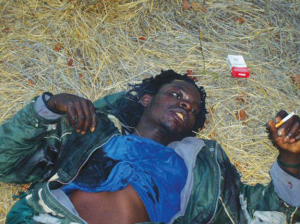News
Latest Lion Aid News
A hypothetical rhino poaching budget - expenditures and profits
Monday 8th October 2012
|
We all know that the legal and illegal trade in rhino horn (largely emanating from South Africa and destined to Vietnam and China) is highly profitable. Let’s look at some numbers from two different sources (CITES and South Africa’s Department of Environmental Affairs). The Department mentions that from 2000-2007, an average of 15 rhinos were poached each year. Things then started going badly wrong – 83 poached in 2008, 122 in 2009, 333 in 2010, 448 in 2011, and about 430 to date in 2012 (it is estimated that the total at this rate will be over 500 this year – 9 rhinos were poached in a single day on October 1 for example). 2007/2008 seem to be the crucial years when the demand for rhino horn grew to stellar levels. South Africa responded to the demand. CITES records indicate South Africa legally supplied 157 horns to Vietnam 2007-2010, 167 live rhinos to China and 16 to Vietnam 2007-2010, 21 “trophies” to China and 177 “trophies” to Vietnam 2007-2010, etc. A TRAFFIC report (see below) questions the number of rhino horn trophies exported to Vietnam citing a total of 657 horns exported from SA while Vietnam cites an import of about 170. Thus 75% of the trade is being under-reported… A Vietnamese Cabinet Minister stated a few years ago that rhino horn cured him of cancer resulting in a big surge of rhino horn imports to that country. The legal trade from South Africa and the hugely increased demand that followed led to the out of control poaching that we see now. Such poaching has resonated across other countries like Zambia, Tanzania and Kenya. It is well known that one kilo of rhino horn has a “street value” of between $65,000 to $100,000 per kilo. That means that the horns of White Rhino (weighing perhaps 4kg) are worth about $260,000 - $400,000. Let me just show you the hypothetical profits that can be made by the poachers and the wildlife trade syndicates in this enterprise by putting together a budget:
NB – the choice of Maputo as an initial transit point is not just off the top of my head, there is evidence that the airport is becoming a major smuggling nexus. In 2012 a Vietnamese national was arrested there attempting to transport seven rhino horns…
Clearly, the illegal trade is highly profitable. South African rhino owners are now charging around $100,000 for a legal rhino hunt, a source of contention as many Vietnamese arrived for “pseudo” trophy hunts – they were given the permits by the provincial authorities (though many of them had never hunted before and did not know how to use a rifle) – and allowed to take back the horn as a legal CITES trophy. However, a recent TRAFFIC report indicates that South Africa is slowly taking measures to close some glaring loopholes. For example, rhino hunts are now restricted to one hunt per individual hunter in a 12 month period; Government officials must be present at every hunt; rhino horns must be microchipped and cannot be exported in personal baggage; and the importing country must demonstrate effective legislation to ensure that trophy horns will remain as “non-commercial personal effects”. In addition, since 2011 South Africa has belatedly demanded that all live rhino exports go to World Association of Zoos and Aquariums approved facilities to circumvent the animals being sent to Chinese and Vietnamese rhino “breeding” facilities that supply rhino horn products as their main activity.
But poaching meanwhile “saves” about 50% of the legal cost, and the savings will probably grow as the rhino owners raise prices in the future and more loopholes are closed. The TRAFFIC report mentioned above indicates that while there might be a decline in the demand for rhino horn in China, it is growing by leaps and bounds in Vietnam. TRAFFIC mentions that 48 hospitals and medical institutes, 240 departments and 9,000 health centres licensed to practice traditional medicine use rhino horn products. Indeed, there is strong evidence that rhino horn “touts” stroll the corridors of cancer wards to offer desperate terminally ill patients and their families a last resort “cure”. Also, rhino horn is a status symbol, investment opportunity and even a form of currency for down payments on luxury items like expensive automobiles etc.
So what can be done? To some extent South Africa is closing a few glaring loopholes, but the poaching continues unabated. Organizations like the SA Private Rhino Owners’ Association are calling for a legalization of trade, and conservation NGOs like the Endangered Wildlife Trust support continued rhino trophy hunting. South Africa did announce recently that it would not seek CITES support at the upcoming Conference of Parties in 2013 to legalize sales of stockpiled rhino horn, and Kenya has put a proposal to the CoP to impose a zero export quota on hunting trophies until 2019. Meanwhile, strides can be made by soliciting increased political will to counter the trade, increased collaborative law enforcement, and increased penalties and deterrents for those implicated rather than the endlessly delayed court cases that are the norm in South Africa.
Picture credit: http://www.beeld.com/Suid-Afrika/Nuus/Zim-renosters-uit-SA-gestroop-20100708
Tags: CITES, Kenya, South Africa, Tanzania, Zimbabwe, China, poaching, Zambia, Vietnam, rhino horn, TRAFFIC, Categories: Traditional Medicine, Illegal Wildlife Trade |
Posted by Pieter Kat at 12:15
No comments have been posted yet.
Add a new comment
Existing user
New user sign up




